Related Research Articles

Streamline Moderne is an international style of Art Deco architecture and design that emerged in the 1930s. Inspired by aerodynamic design, it emphasized curving forms, long horizontal lines, and sometimes nautical elements. In industrial design, it was used in railroad locomotives, telephones, toasters, buses, appliances, and other devices to give the impression of sleekness and modernity.
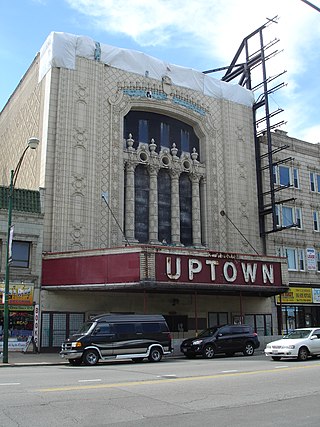
A movie palace is a large, elaborately decorated movie theater built from the 1910s to the 1940s. The late 1920s saw the peak of the movie palace, with hundreds opening every year between 1925 and 1930. With the advent of television, movie attendance dropped, while the rising popularity of large multiplex chains in the 1980s and 1990s signaled the obsolescence of single-screen theaters. Many movie palaces were razed or converted into multiple-screen venues or performing arts centers, though some have undergone restoration and reopened to the public as historic buildings.

Fox Theatres was a large chain of movie theaters in the United States dating from the 1920s either built by Fox Film studio owner William Fox, or subsequently merged in 1929 by Fox with the West Coast Theatres chain, to form the Fox West Coast Theatres chain. Fox West Coast went into bankruptcy and was sold to The National Theatres Corporation, led by Charles Skouras, on November 20, 1933, for $17,000,000.00. Eugene V. Klein later became CEO of National, and turned it into the conglomerate National General. Mann Theatres bought National General's theatres in 1973.
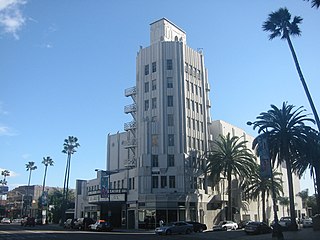
The Saban Theatre is a historic theatre in Beverly Hills, California, formerly known as the Fox Wilshire Theater. It is an Art Deco structure at the southeast corner of Wilshire Boulevard and Hamilton Drive designed by architect S. Charles Lee and is considered a classic Los Angeles landmark. The building was listed on the National Register of Historic Places on April 3, 2012.

The Alex Theatre is a landmark located at 216 North Brand Boulevard in Glendale, California, United States. It is currently owned by the city of Glendale and operated by SAS. The theater's capacity is 1,400.

Broadway, until 1890 Fort Street, is a thoroughfare in Los Angeles County, California, United States. The portion of Broadway from 3rd to 9th streets, in the Historic Core of Downtown Los Angeles, was the city's main commercial street from the 1910s until World War II, and is the location of the Broadway Theater and Commercial District, the first and largest historic theater district listed on the National Register of Historic Places (NRHP). With twelve movie palaces located along a six-block stretch of Broadway, it is the only large concentration of movie palaces left in the United States.

Stiles Oliver Clements was an architect practicing in Los Angeles and Southern California.
Charles Luckman was an American businessman, property developer, and architect known for designing landmark buildings in the United States such as the Theme Building, Prudential Tower, Madison Square Garden, and The Forum. He was named the "Boy Wonder of American Business" by Time magazine when president of the Pepsodent toothpaste company in 1939. Through acquisition, he later became president of Lever Brothers. Luckman would later collaborate with William Pereira, in which the two would form their architectural firm, Pereira & Luckman, in 1950. Pereira & Luckman would later dissolve by 1958, parting ways for both himself and Pereira. Luckman would continue successfully with his own firm, Charles Luckman Associates. Luckman retired from the firm, although he would still be present.
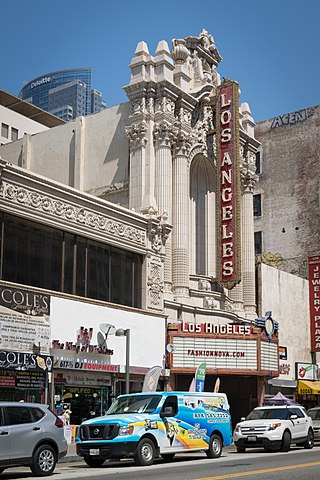
The Los Angeles Theatre is a 2,000-seat historic movie palace at 615 S. Broadway in the historic Broadway Theater District in Downtown Los Angeles.

The Broadway Theater District in the Historic Core of Downtown Los Angeles is the first and largest historic theater district listed on the National Register of Historic Places (NRHP). With twelve movie palaces located along a six-block stretch of Broadway, it is the only large concentration of movie palaces left in the United States. The same six-block stretch of Broadway, and an adjacent section of Seventh Street, was also the city's retail hub for the first half of the twentieth century, lined with large and small department stores and specialty stores.

Arthur Froehlich, was an American architect in Beverly Hills, California. His firm, Arthur Froehlich & Associates, is known for their mid-century commercial building designs, and thoroughbred horse racetracks.
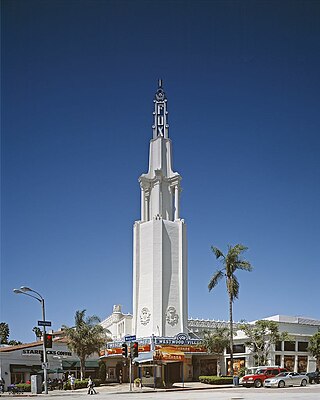
The Regency Village Theatre is a historic, landmark cinema in Westwood, Los Angeles, California. Westwood Village, in the heart of Westwood, is near the University of California, Los Angeles (UCLA). It is currently operated by the Regency Theaters chain. The Westwood Village Theatre has been the site for many Hollywood movie premieres in Los Angeles. The seating capacity of the cinema is about 1,400.

The Fox Bruin Theater is a 670-seat movie palace located in the Westwood neighborhood of Los Angeles, California, near University of California, Los Angeles (UCLA). It is currently operated by Regency Theaters under the name Regency Bruin Theatre.
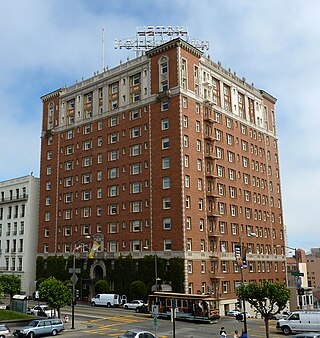
Weeks and Day was an American architectural firm founded in 1916 by architect Charles Peter Weeks (1870–1928) and engineer William Peyton Day (1886–1966).

The Carthay Circle Theatre was one of the most famous movie palaces of Hollywood's Golden Age. Located on San Vicente Boulevard in Los Angeles, California, it opened in 1926 and was demolished in 1969.

The Tower Theatre for the Performing Arts is a historic Streamline Moderne mixed-use theater in Fresno, California. Built in 1939, it opened to the public on December 15, 1939, under the management of Fox West Coast Theater Corporation. The building was designed by S. Charles Lee, with its tower inspired by the "Star Pylon" at the 1939 New York World's Fair. The theater underwent a renovation and reopened as a performing arts center in 1990, after being closed as a repertory cinema in 1989 due to financial troubles.
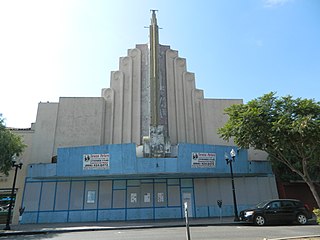
The Fox Theater Inglewood in downtown Inglewood, California is a now-closed but architecturally significant movie theater that is listed on the National Register of Historic Places. The building, designed in the Streamline Moderne style, was designed by S. Charles Lee in 1949.
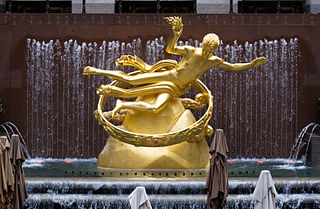
The Art Deco style, which originated in France just before World War I, had an important impact on architecture and design in the United States in the 1920s and 1930s. The most notable examples are the skyscrapers of New York City, including the Empire State Building, Chrysler Building, and Rockefeller Center. It combined modern aesthetics, fine craftsmanship, and expensive materials, and became the symbol of luxury and modernity. While rarely used in residences, it was frequently used for office buildings, government buildings, train stations, movie theaters, diners and department stores. It also was frequently used in furniture, and in the design of automobiles, ocean liners, and everyday objects such as toasters and radio sets.
The De Anza Theatre is an office building and former theatre with approximately 800 seats located at 4225 Market Street in Riverside, California in the United States. The De Anza was designed circa 1937 by Fox West Coast theater architect S. Charles Lee and constructed circa 1938 by local Riverside builder T.C. Prichard. Southern California-based Lee had "one of the most celebrated and prolific careers" in the history of theatre design; the De Anza is the only Lee building in Riverside. Architectural photographer Julius Shulman shot the Streamline Moderne-style building at the time of opening; Shulman "did not merely document significant architecture, but interpreted it, becoming one of the most important and influential architectural photographers in history."
References
- ↑ "Movie Theaters Designed by Simeon Charles Lee - Cinema Treasures". cinematreasures.org. Cinema Treasures, LLC. Retrieved 13 July 2016.
- 1 2 3 4 5 6 7 Powell, John Edward (1996). "S. Charles Lee". A Guide to Historic Architecture in Fresno, California. Retrieved 2008-02-04.
- 1 2 3 Scheid, Ann (2000-03-13). "S. Charles Lee: Architect". The S. C. Lee Collection. UCLA Library. Retrieved 2008-02-04.
- ↑ "S. Charles Lee". historicfresno.org. Retrieved 2019-05-11.
- ↑ "Fox Phoenix Theatre". Cinema Treasures. Retrieved 13 July 2016.
- 1 2 "California Synagogue in Mission Tradition" (PDF). Architectural Record . 100 (4). Concord, NH and New York, NY: F. W. Dodge Corporation: 104 (PDF p. 96). October 1946. Retrieved 2018-10-19.